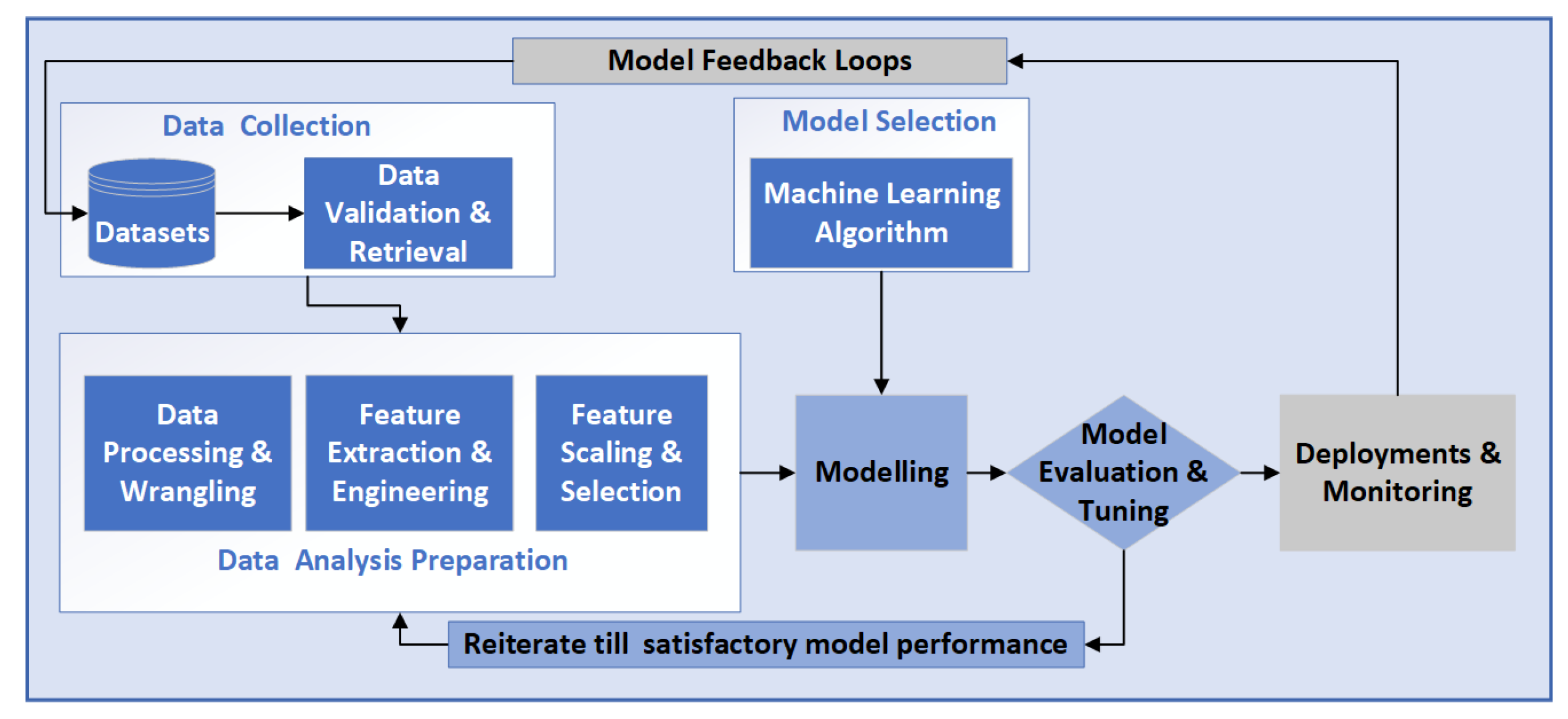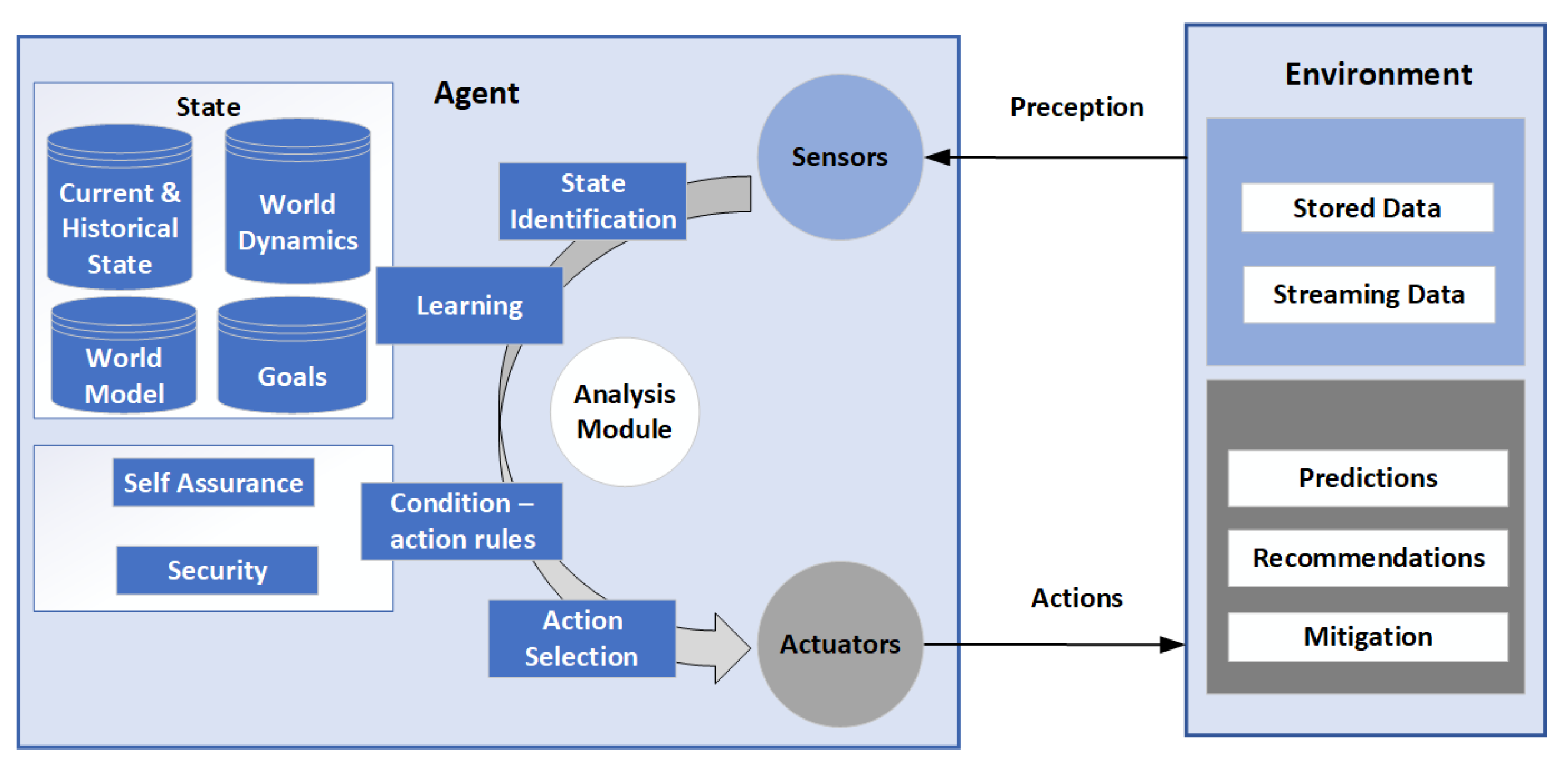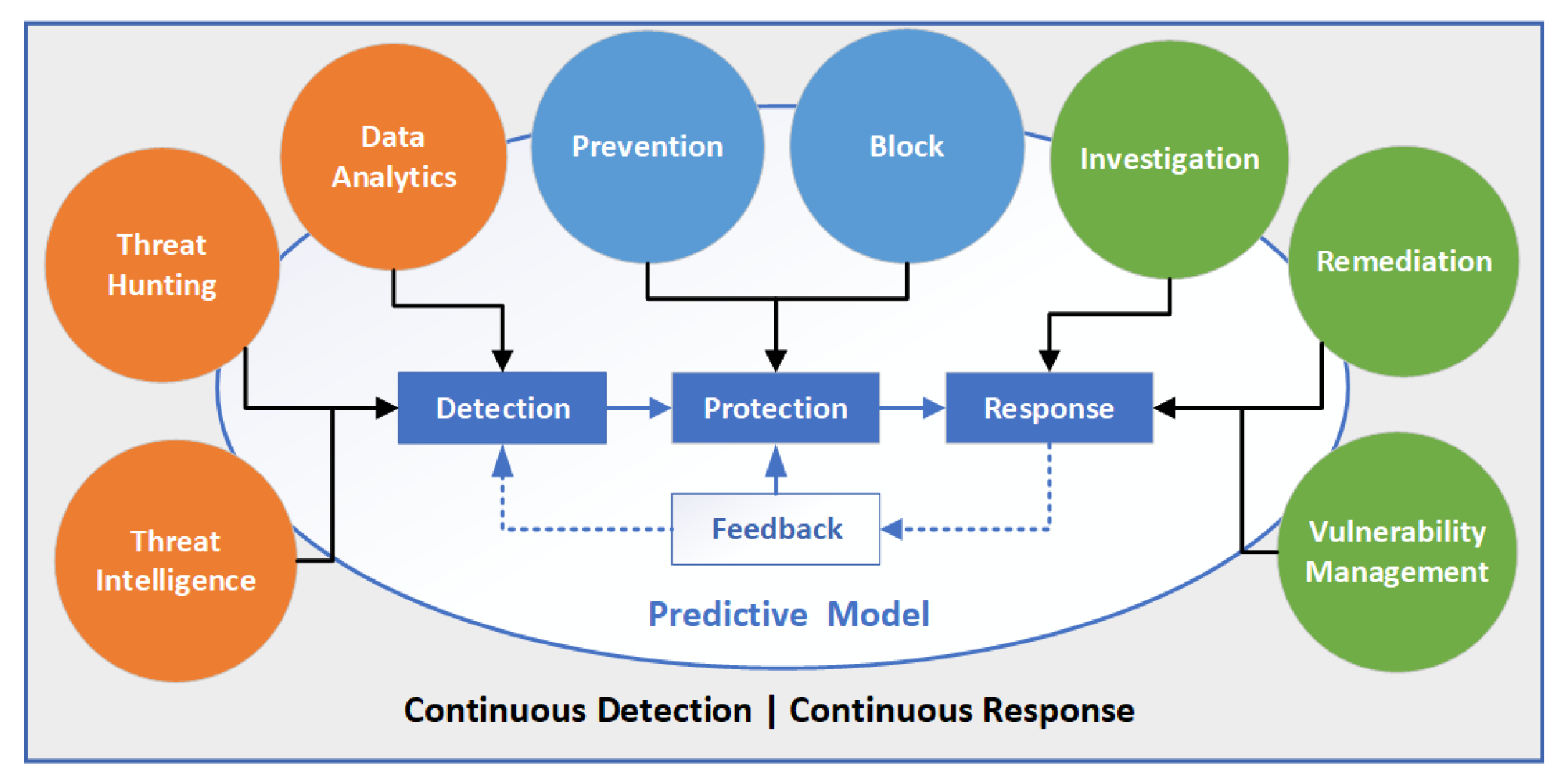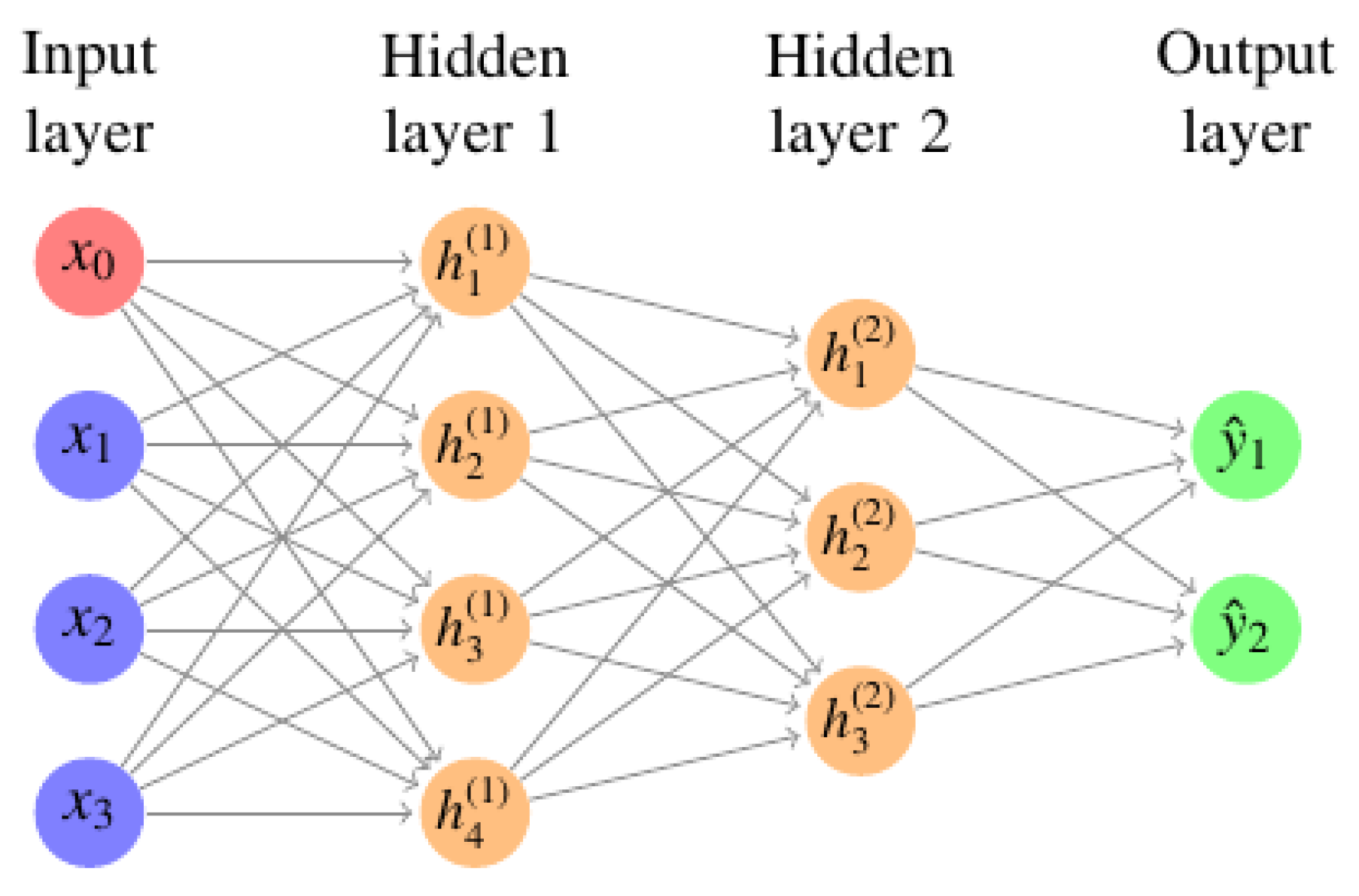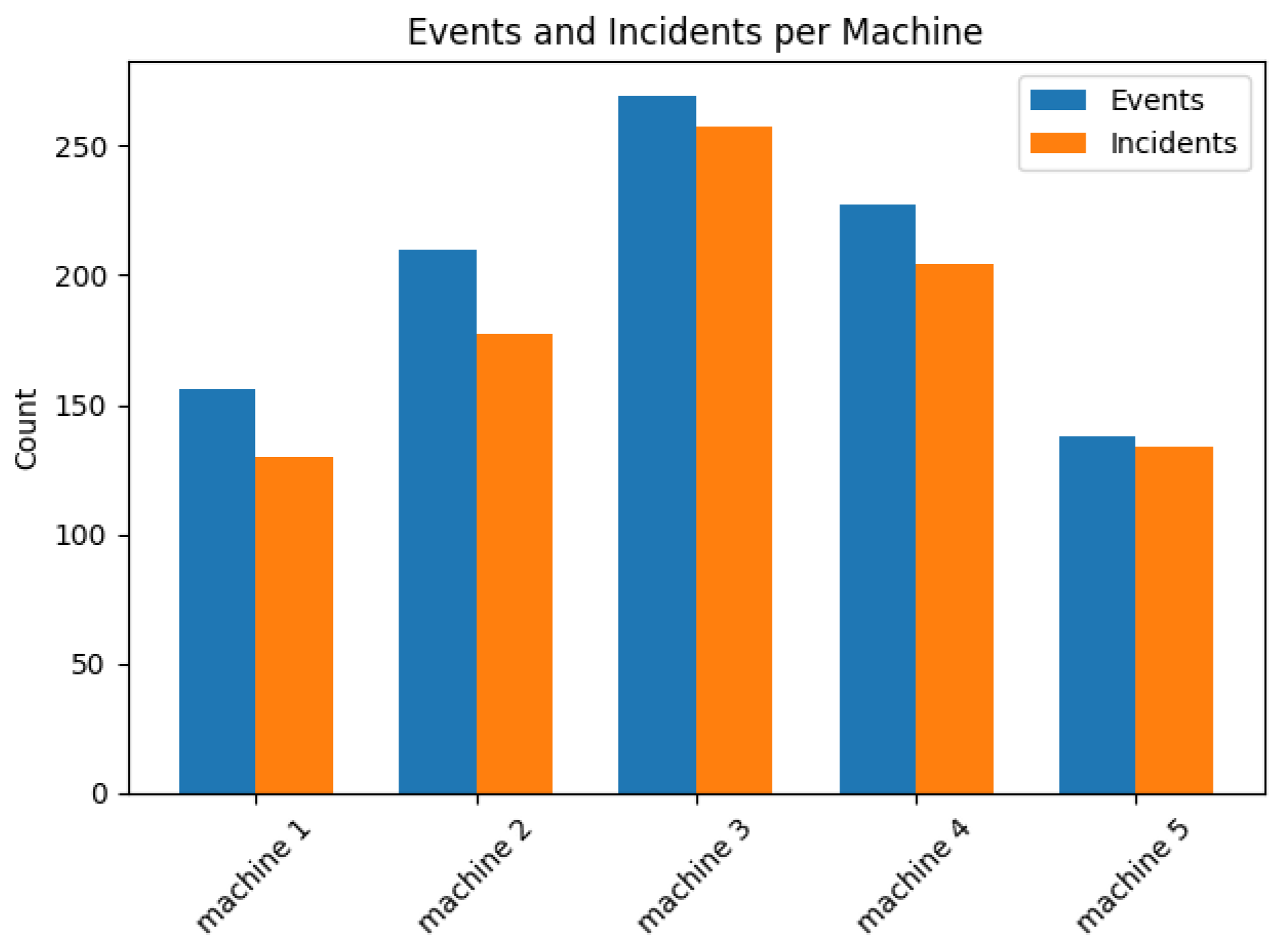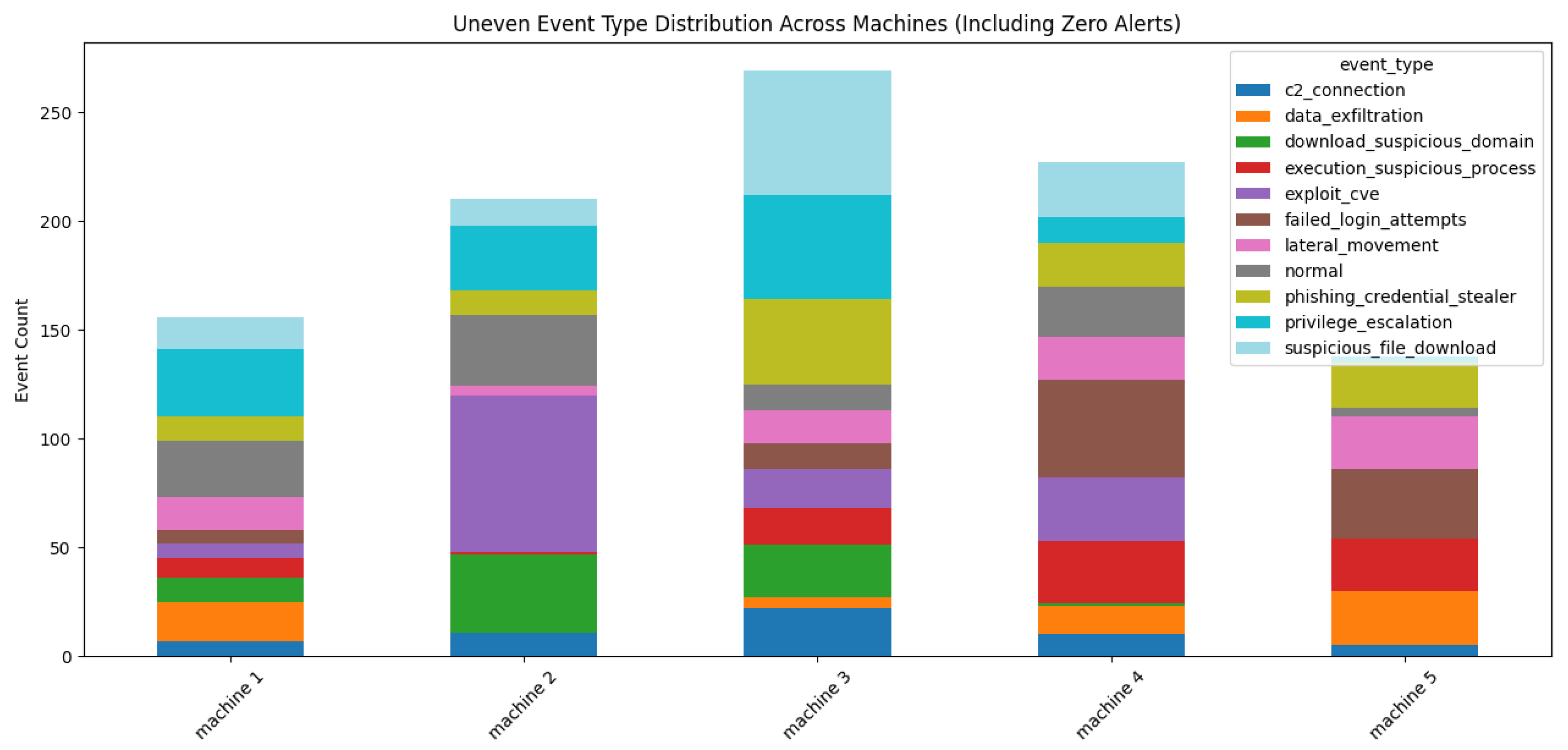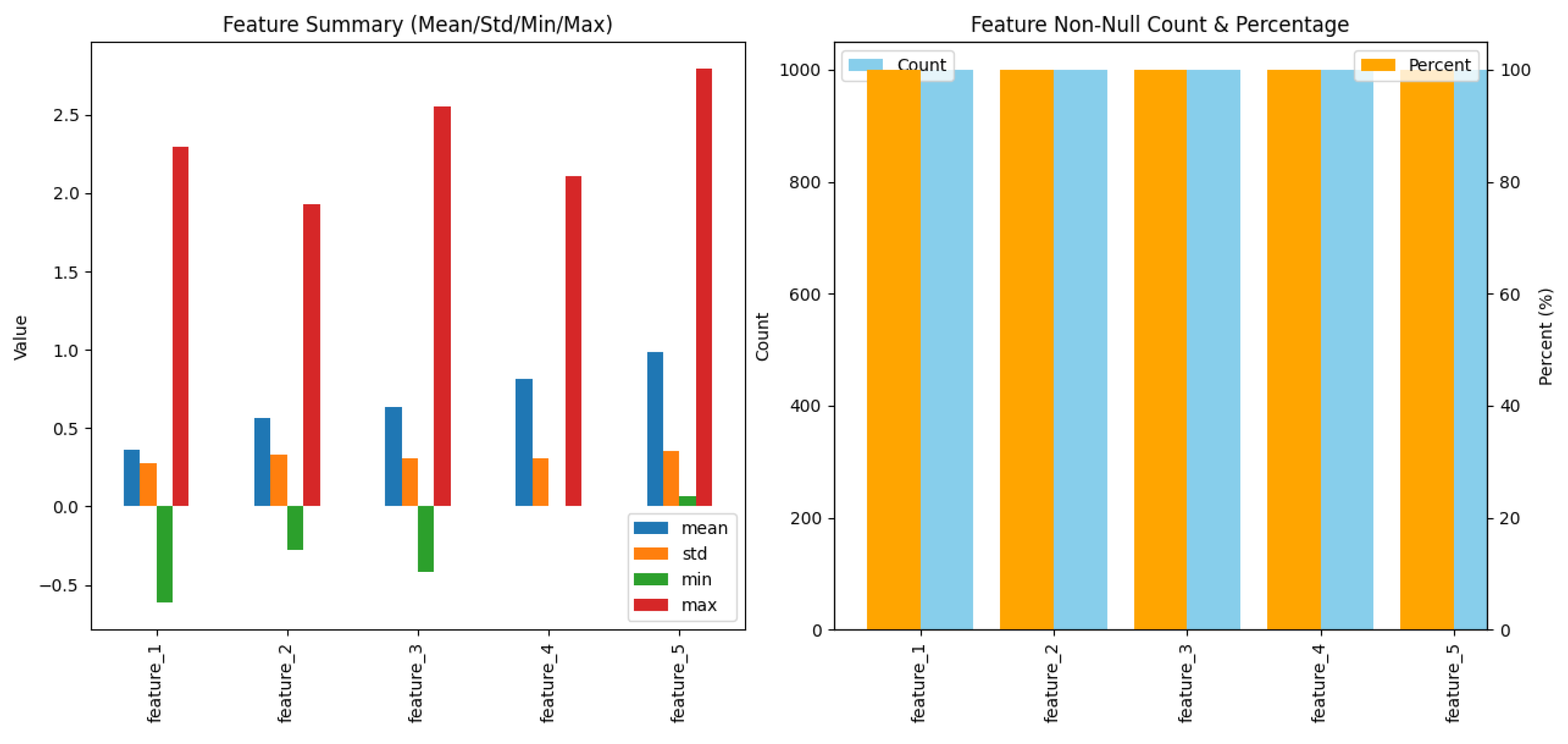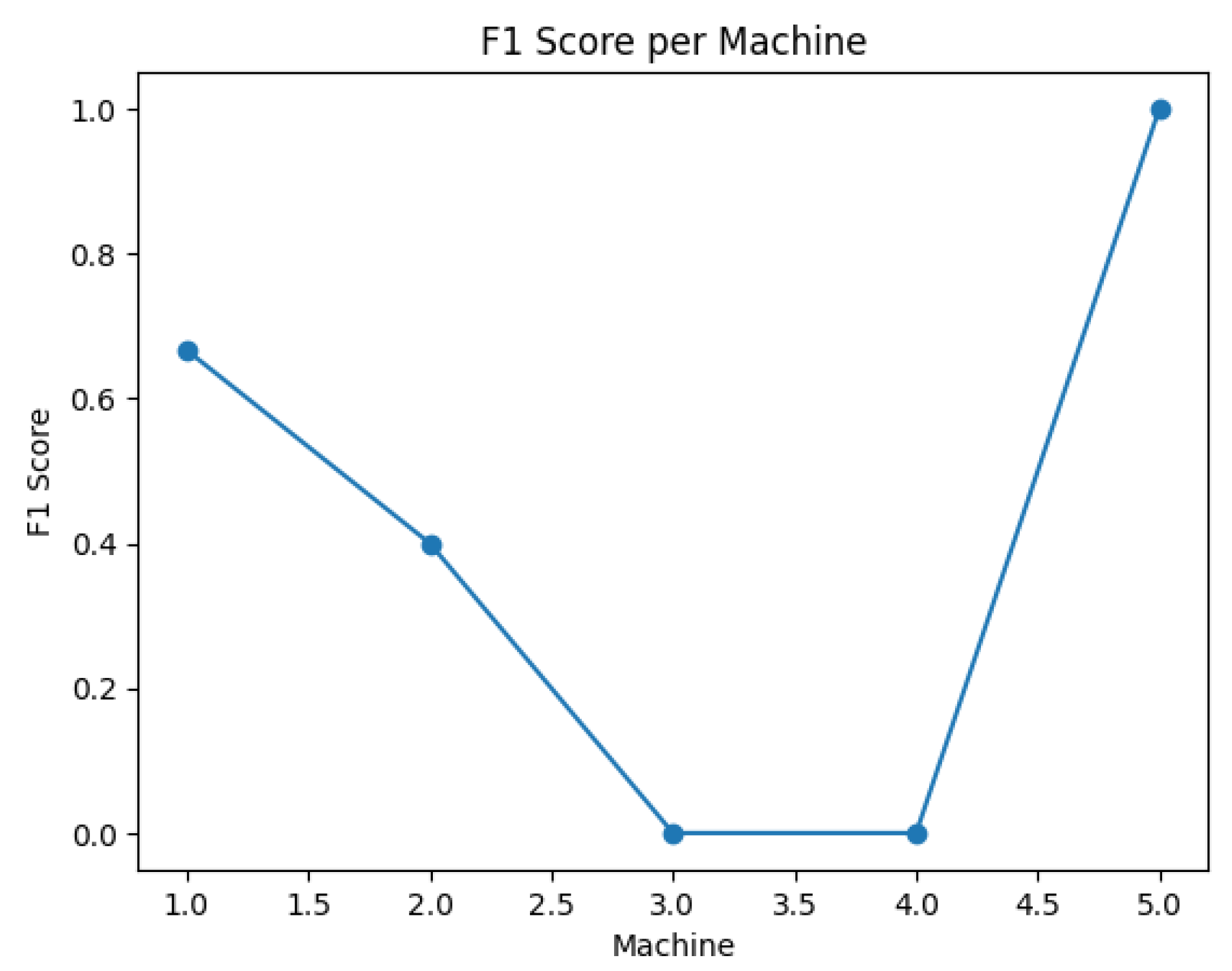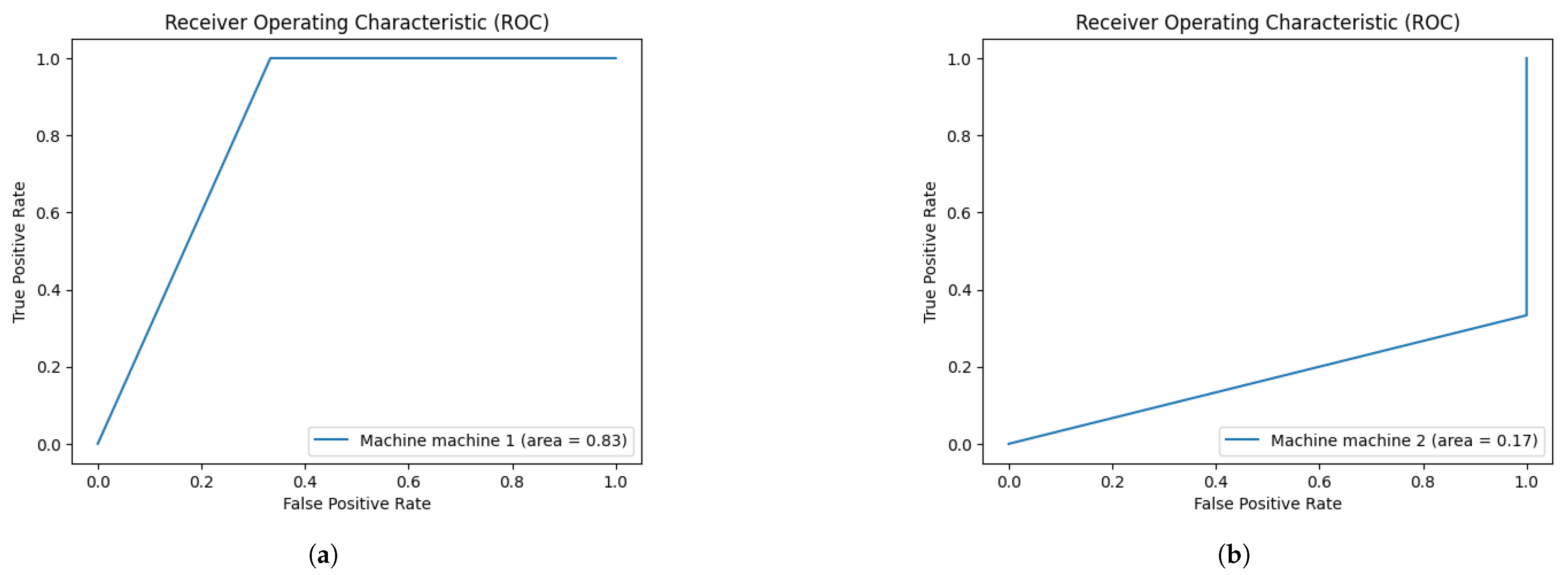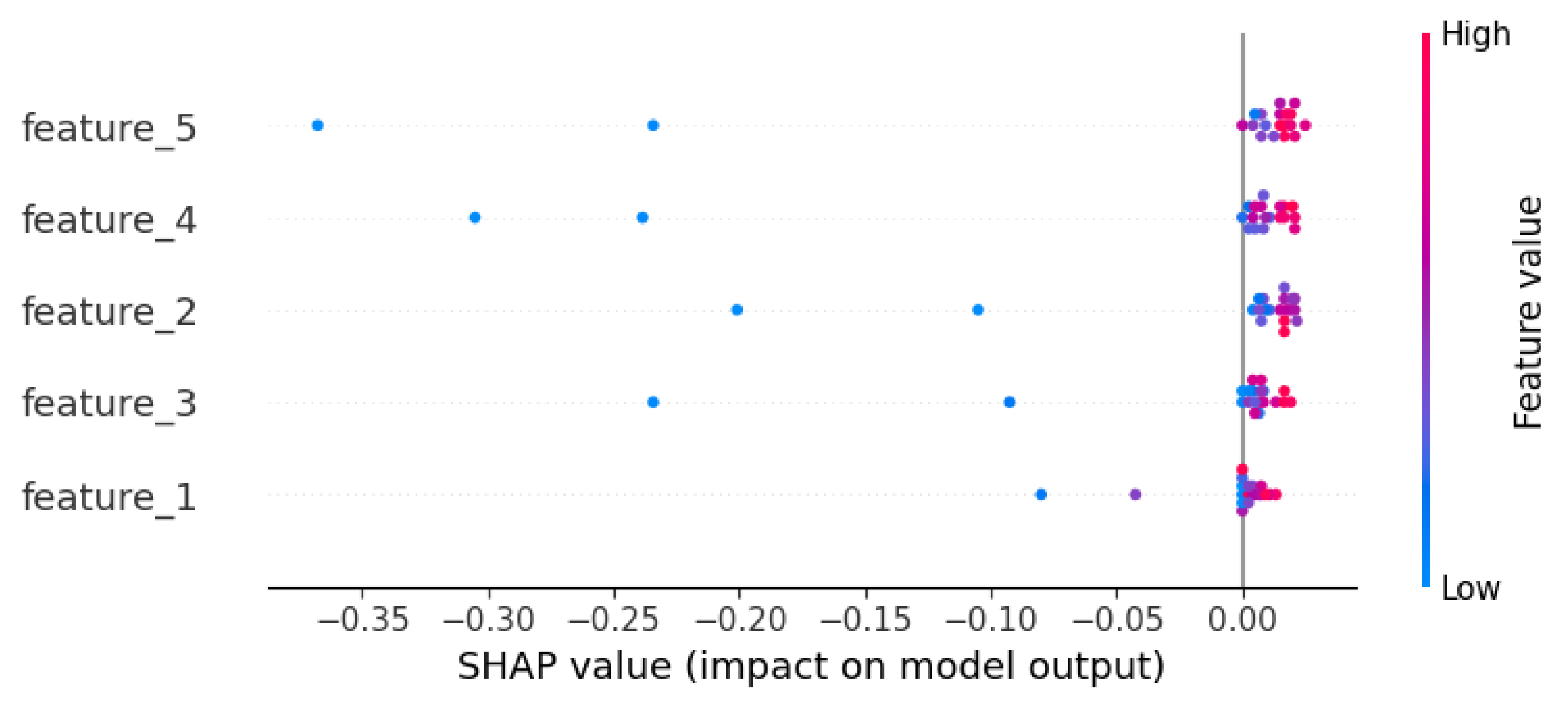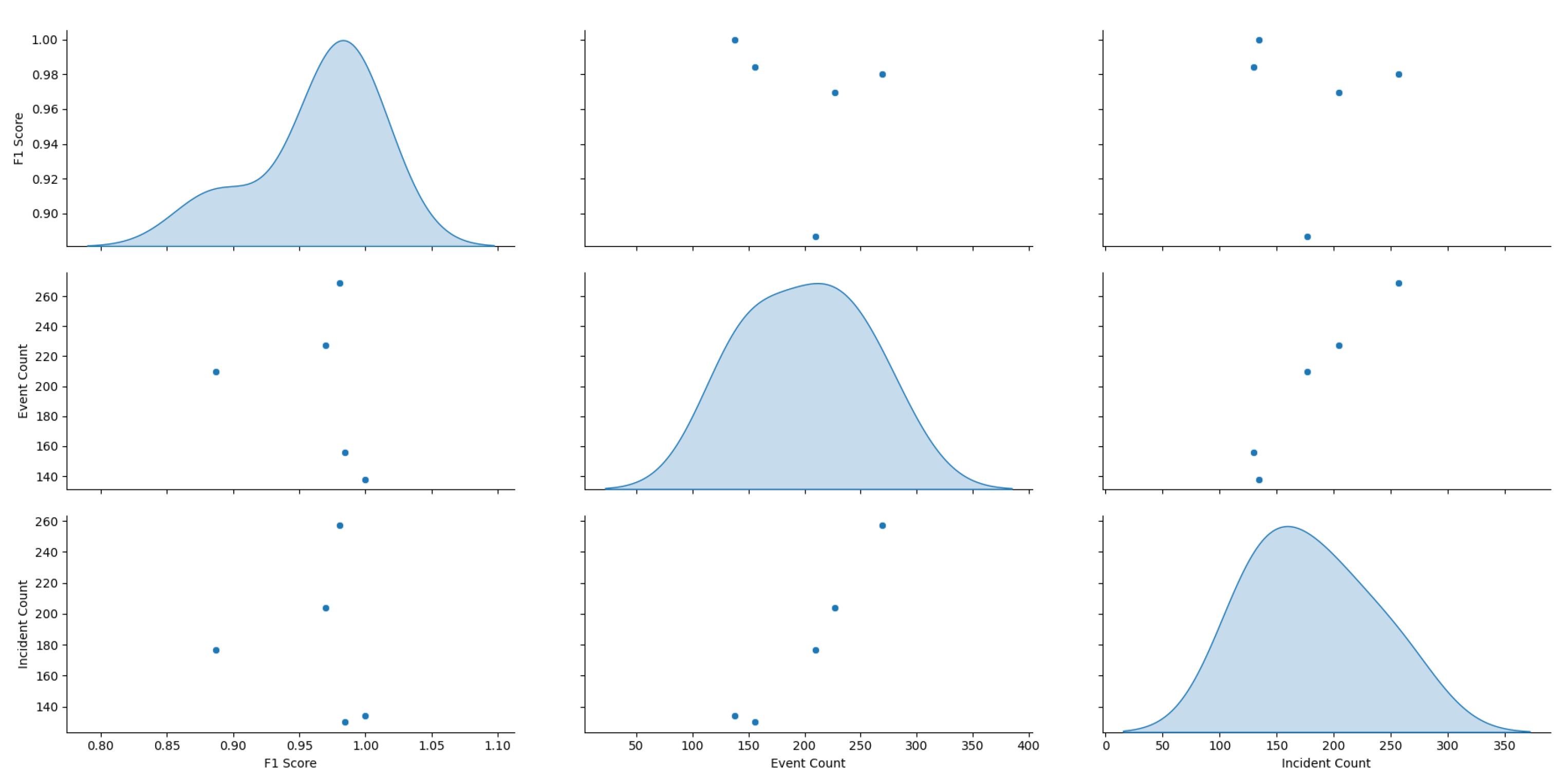1. Introduction
Cybersecurity is a fast-evolving discipline, and threat actors (TAs) constantly endeavour to stay ahead of security teams with new and sophisticated attacks. The use of interconnected devices to access data ubiquitously has increased exponentially, raising more security concerns. Traditional security solutions are becoming inadequate in detecting and preventing such attacks. However, advances in cryptographic and Artificial Intelligence (AI) techniques show promise in enabling cybersecurity experts to counter such attacks [
1]. AI is being leveraged to solve a number of problems, from using chatbots to virtual assistants to automation, allowing humans to focus on higher-value work; they are also used for predictions, analytics, and cybersecurity.
Recovery from a data breach costs USD 4.35 million on average and takes 196 days [
2]. Organisations are increasingly investing in cybersecurity, adding AI enablement to improve threat detection, incident response (IR), and compliance. Patterns in data can be recognised using Machine Learning (ML), monitoring, and threat intelligence to enable systems to learn from past events. It is estimated that AI in the cybersecurity market will be worth USD 102.78 billion by 2032 globally [
3]. Currently, different initiatives are defining new standards and certifications to elicit users’ trust in AI. The adoption of AI can improve best practices and security posture, but it can also create new forms of attacks. Therefore, secure, trusted, and reliable AI is necessary, achieved by integrating security in the design, development, deployment, operation, and maintenance stages.
Failures of AI systems are becoming common, and it is crucial to understand them and prevent them as they occur [
4,
5]. Failures in general AI have a higher impact than in narrow AI, but a single failure in a superintelligent system might result in a catastrophic disaster with no prospect of recovery. AI safety can be improved with cybersecurity practices, standards, and regulations. Its risks and limitations should also be understood, and solutions should be developed. Systems commonly experience recurrent problems with scalability, accountability, context, accuracy, and speed in the field of cybersecurity [
6]. The inventory of ML algorithms, techniques, and systems have to be explored through the lens of security. Considering the fact that AI can fail, there should be models in place to make AI decisions explainable [
7].
How can an ML-driven system effectively detect and predict cybersecurity incidents in a dynamic and scalable multimachine environment using alert-level intelligence? This paper addresses this question by exploring AI and cybersecurity with use cases and practical concepts in a real-world context based on the field experience of the authors. It gives an overview of how AI and cybersecurity empower each other symbiotically. It discusses the main disciplines of AI and how they can be applied to solve complex cybersecurity problems and the challenges of data analytics. It highlights the need to evaluate both AI for security and security for AI to deploy safe, trusted, secure AI-driven applications. Furthermore, it develops an algorithm and a predictive model, the Malicious Alert Detection System (MADS), to demonstrate AI applicability. It evaluates the model’s performance; proposes methods to address AI-related risks, limitations, and attacks; explores evaluation techniques; and recommends a safe and successful adoption of AI.
The rest of this paper is structured as follows.
Section 2 reviews related work on AI and cybersecurity. In
Section 3, the security objectives and AI foundational concepts are presented.
Section 4 discusses how AI can be leveraged to solve security problems. The utilisation of ML algorithms is presented in
Section 6.
Section 5 presents a case study of a predictive AI model, MADS, and its evaluation. The risks and limitations of AI are discussed in
Section 7. This paper is concluded with remarks and a discussion of future works in
Section 8.
2. Background
Security breaches and loss of confidential data are still big challenges for organisations. With the increased sophistication of modern attacks, there is a need to detect malicious activities and also to predict the steps that will be taken by an adversary. This can be achieved through the utilisation of AI by applying it to use cases such as traffic monitoring, authentication, and anomalous behaviour [
8].
Current AI research involves search algorithms, knowledge graphs, Natural Languages Processing (NLP), expert systems, ML, and Deep Learning (DL), while the development process includes perceptual, cognitive, and decision-making intelligence. The integration of cybersecurity with AI has huge benefits, such as improving the efficiency and performance of security systems and providing better protection from cyber-threats. It can improve an organisation’s security maturity by adopting a holistic view, combining AI with human insight. Thus, the socially responsible use of AI is essential to further mitigate related concerns [
9].
The speed of processes and the amount of data used in defending cyberspace cannot be handled without automation. AI techniques are being introduced to construct smart models for malware classification, intrusion detection, and threat intelligence gathering [
10]. Nowadays, it is difficult to develop software with conventional fixed algorithms to defend against dynamically evolving cyberattacks [
11]. AI can provide flexibility and learning capability to software development. However, TAs have also figured out how to exploit AI and use it to carry out new attacks.
Moreover, ML and neural network (NN) policies in Reinforcement Learning (RL) methods are vulnerable to adversarial learning attacks, which aim at decreasing the effectiveness of threat detection [
12,
13,
14]. AI models face threats that disturb their data, learning, and decision-making. Deep Reinforcement Learning (DRL) can be utilised to optimise security defence against adversaries using proactive and adaptive countermeasures [
15]. The use of a recursive algorithm, DL, and inference in NNs have enabled inherent advantages over existing computing frameworks [
16]. AI-enabled applications can be combined with human emotions, cognitions, social norms, and behavioural responses [
17] to improve societal issues. However, the use of AI can lead to ethical and legal issues, which are already big problems in cybersecurity. There are significant concerns about data privacy and applications’ transparency. It is also important to address the criminal justice issues related to AI usage, liability, and damage compensation.
Recent advancements introduced DL techniques, such as Convolutional Neural Networks (CNNs) and Long Short-Term Memory (LSTM) networks, which have demonstrated improved detection capabilities in temporal and structured data streams [
18,
19]. Despite their accuracy, DL models are often considered “black-box” in nature, providing little transparency or control to cybersecurity analysts [
20]. Moreover, these models typically classify individual events in isolation, lacking the contextual correlation necessary for understanding attack campaigns or incidents. Studies show that AI-based detectors can be deceived through carefully crafted inputs [
21]. This vulnerability underscores the need for robust and interpretable detection architectures that not only predict threats but also do so with resilience to adversarial manipulation.
In light of these limitations, MADS distinguishes itself by integrating ML prediction, k-nearest neighbours (k-NN)-based voting [
22], and incident-level correlation within a sliding window framework. Unlike conventional ML classifiers that operate in a stateless manner, it retains a temporal alert history, allowing for contextual decisions based on cumulative patterns [
23]. Its hybrid decision-making process reduces susceptibility to isolated misclassifications and enhances trust through interpretable thresholds and voting confidence. Furthermore, MADS is explicitly designed to handle multisource alert streams from distributed machines, a capability often overlooked in single-node systems.
The existing AI-based solutions focus on enhancing detection accuracy or reducing false alarms [
24], but few address holistic incident formation and operational scalability across networked devices. This paper bridges this gap by introducing a multistage detection and aggregation pipeline that is both adaptive and transparent, making it well suited for modern threat environments. It introduces a novel integration of DL and neighbourhood-based voting within a multimachine alert stream processing framework.
2.1. Artificial Intelligence
For a system to be considered to have AI capability, it must have at least one of the six foundational capabilities to pass the Turing Test [
25] and the Total Turing Test [
26]. These give AI the ability to understand the natural language of a human being, store and process information, reason, learn from new information, see and perceive objects in the environment, and manipulate and move physical objects. Some advanced AI agents may possess all six capabilities.
The advancements of AI will accelerate, making it more complex and ubiquitous, leading to the creation of a new level of AI. There are three levels of AI [
27]:
- 1.
Artificial Narrow Intelligence (ANI): The first level of AI that specialises in one area but cannot solve problems in other areas autonomously.
- 2.
Artificial General Intelligence (AGI): AI that reaches the intelligence level of a human, having the ability to reason, plan, solve problems, think abstractly, comprehend complex ideas, learn quickly, and learn from experience.
- 3.
Artificial Super Intelligence (ASI): AI that is far superior to the best human brain in all cognitive domains, such as creativity, knowledge, and social abilities.
Even ANI models have been able to disrupt technology unexpectedly, such as generative and agentic AI, chatbots, and predictive models. AI enables security systems such as Endpoint Detection and Response (EDR) and IDS to store, process, and learn from huge amounts of data [
28,
29]. These data are ingested from network devices, workstations, and the Application Programming Interface (API), which is used to identify patterns such as sign-in logs, locations, time-zone, connection types, and abnormal behaviours. These applications can take actions using the associated sign-in risk score and security policies to automatically block login attempts or enforce strong authentication requirements [
30].
2.1.1. Learning and Decision-Making
The discipline of learning is the foundation of AI. The ability to learn from input data moves systems away from the rule-based programming approach. An AI-enabled malware detection system operates differently from a traditional signature-based system. Rather than relying on a predefined list of virus signatures, the system is trained using data to identify abnormal program execution patterns known as behaviour-based or anomaly detection, which is a foundational technique used in malware and intrusion detection systems [
31].
In the traditional approach, a software engineer identifies all possible inputs and conditions that software will be subjected to, but if the program receives an input that it is not designed to handle, it fails [
32]. For instance, when searching for a Structured Query Language (SQL) injection in server logs, in the programming approach, the vulnerability scanner will continuously look for parameters that are not within limits [
33]. Additionally, it is complicated to manage multiple vulnerabilities with traditional vulnerability management methods. However, an intelligent vulnerability scanner foresees the possible combinations and ranges, using a learning-based approach. The training data, like source codes or program execution contexts, are fed to the model to learn and act on new data following the ML pipeline in
Figure 1 [
34].
2.1.2. Artificial Intelligence and Cybersecurity
An intelligent agent is used to maximise the probability of goal completion. It is fed huge amounts of data, learns patterns, analyses new data, and presents it with recommendations for analysts to make decisions, as shown in
Figure 2 [
35]. AI can be used to complement traditional tools together with policies, processes, personnel, and methods to minimise security breaches.
Utilising AI can improve the efficiency of vulnerability assessment with better accuracy and make sense of statistical errors [
36]. Threat modelling in software development is still a manual process that requires security engineers’ input [
37,
38]. Applying AI to threat modelling still needs more research [
39], but AI has already made a great impact on threat detection [
6,
35]. Moreover, it is being utilised in IR, providing information about attack behaviour, the TA’s Tactics, Techniques, and Procedures (TTPs), and the threat context [
40].
3. Objectives and Approaches
This Section explores foundational concepts in, objectives of, and approaches to cybersecurity.
3.1. Systems and Data Security
The main security objective of an organisation is to protect its systems and data from threats by providing Confidentiality, Integrity, and Availability (CIA). Security is enforced by orchestrating frameworks of defensive techniques [
41,
42] embedded in the organisation’s security functions to align with business objectives. This includes applying controls that protect the organisation’s assets using traditional and AI-enabled security tools.
This enables security teams to identify, contain, and remediate any threats with lessons learned for feedback to fine-tune the security controls. The feedback loop is also used for retraining ML models with new threat intelligence, newly discovered behaviour patterns, and attack vectors, as shown in
Figure 3. In addition, orchestrating security frameworks needs a skilled team, but there is a shortage of such professionals [
43]. Therefore, a strategic approach to employment, training, and education of the workforce is required. Moreover, investment in secure design, automation, and AI can augment security teams and improve efficiency.
3.2. Security Controls
A security incident is prevented by applying overlapping administrative, technical, and physical controls complemented with training and awareness across the organisation as shared responsibility. The security policies should be clearly defined, enforced, and communicated throughout the organisation [
44] and championed by the leadership. Threat modelling, secure designing, and coding best practices must be followed, together with vulnerability scanning of applications and systems [
45]. Defence in-depth controls must be applied to detect suspicious activities and monitor TAs’ TTPs, unwarranted requests, file integrity, system configurations, malware, unauthorised access, social engineering, unusual patterns, user behaviours, and inside threats [
46].
When a potential threat is observed, the detection tool should alert in real time so that the team can investigate and correlate events to assist in decision-making and response to the threat [
47], utilising tools like EDR, Security Information and Event Management (SIEM), and Security Orchestration, Automation, and Response (SOAR). These tools provide a meaningful context about the security events for accurate analysis. If it is a real threat, the impacted resource can be isolated and contained to stop the attack from spreading to unaffected assets following the IR plan [
48].
4. Cybersecurity Problems
This section discusses security problems and how AI can improve cybersecurity by solving pattern problems.
4.1. Improving Cybersecurity
Traditional network security was based on creating security policies, understanding the network topography, identifying legitimate activity, investigating malicious activities and enforcing a zero-trust model. Large networks may find this tough, but enterprises can use AI to enhance network security by observing network traffic patterns and advising functional groupings of workloads and policies. The traditional techniques use signatures or Indicators of Compromise (IOC) to identify threats, but this is not effective against unknown threats. AI can increase detection rates but can also increase False Positives (FPs) [
49]. The best approach is combining both traditional and AI techniques, which can result in a better detection rate and minimising FPs. Integrating AI with threat hunting can improve behavioural analytics and visibility, and it can be used to develop applications and users’ profiles [
50].
AI-based techniques like User and Event Behavioural Analytics (UEBA) can analyse the baseline behaviour of user accounts and endpoints, and they can identify anomalous behaviour such as a zero-day attack [
51]. AI can optimise and continuously monitor processes like cooling filters, power consumption, internal temperatures, and bandwidth usage to alert for any failures and provide insights into valuable improvements to the effectiveness and security of the infrastructure [
52].
4.2. Scale Problem and Capability Limitation
TAs are likely to leave a trail of their actions. Security teams use the context from data logs to investigate any intrusion, but this is very challenging. They also rely on tools like Intrusion Detection Systems (IDSs), anti-malware, and firewalls to expose suspicious activities, but these tools have limitations, as some are rule-based and do not scale well in handling massive amounts of data.
An IDS constantly scans for signatures by matching known patterns in the malicious packet flow or binary code. If it fails to find a signature in the database, it will not detect the intrusion, and the impending attack will stay undetected. Similarly, to identify attacks, such as brute force or Denial of Service (DoS), it has to go through large amounts of data over a period of time [
53] and analyse attributes such as source Internet Protocol (IP) addresses, ports, timestamps, protocols, and resources. This may lead to a slow response or incorrect correlation by the IDS algorithm.
The use of ML models improves detection and analysis in IDSs. They can identify and model the real capabilities and circumstances required by attackers to carry out successful attacks. This can harden defensive systems actively and create new risk profiles [
29]. A predictive model can be created by training on data features that are necessary to detect an anomaly and determine if a new event is an intrusion or benign activity [
54].
4.3. Problem of Contextualisation
Organisations must ensure that employees do not share confidential information with undesired recipients. Data Loss Prevention (DLP) solutions are deployed to detect, block, and alert if any confidential data cross the trusted parameter of the network [
55]. Traditional DLP uses a text-matching technique to look for patterns against a set of predetermined words or phrases [
56]. However, if the threshold is set too high, it can restrict genuine messages, while if it is set too low, confidential data such as personal health records might end up in users’ personal cloud storage, violating user acceptability and data privacy policies.
An AI-enabled DLP can be trained to identify sensitive data based on a certain context [
57]. The model is fed words and phrases to protect, such as intellectual property, personal information [
58], and unprotected data that must be ignored. Additionally, it is fed information about semantic relationships among the words using embedding techniques and then trained using algorithms such as Naive Bayes. The model will be able to recognise the spatial distance between words, assign a sensitivity level to a document, and make a decision to block the transmission and generate a notification [
59].
4.4. Process Duplication
TAs change their TTPs often [
42], but most security practices remain the same, with repetitive tasks that lead to complacency and the missing of tasks [
60]. An AI-based approach can check duplicative processes, threats, and blind spots in the network that could be missed by an analyst. AI self-adaptive access control can prevent duplication of medical data with smart, transparent, accountable secure duplication methods [
61].
To identify the timestamp of an attack payload delivery, the user’s device log data are analysed for attack prediction by preprocessing the dataset and creating a DL classification to remove duplicate and missing values [
62].
4.5. Observation Error Measurement
There is a need for accuracy and precision when analysing potential threats, as a TA has to be right only once to cause significant damage, while a security team has to be right every time [
60]. Similarly, if a security team discovers events in the log files that point to a potential breach, validation is required to confirm if it is a True Positive (TP) or FP. But validating false alerts is inefficient and a waste of resources, and it distracts the security team from real attacks [
63].
An attacker can trick a user into clicking on a Uniform Resource Locator (URL) that leads to a phishing site that asks for a username and password [
64]. Traditional controls are blind to phishing attacks, and phishing emails look more credible nowadays. These websites are found by comparing their URL against block lists [
65], which become outdated quickly, leading to statistical errors, as shown in
Figure 4. Moreover, a genuine website might be blocked due to wrong classification, or a new fraud website might not be detected. This requires an intelligent solution to analyse a website in different dimensions and characterise it correctly based on its reputation, certificate provider, domain records, network characteristics, and site content. A training model can use these features to learn and accurately categorise, detect, block, and report new phishing patterns [
66].
4.6. Time to Act
A security team should go through the logs quickly and accurately, otherwise a TA could get into the system and exfiltrate data without being detected. Today’s adversaries take advantage of the noisy network environment, and they are patient, persistent, and stealthy [
67]. The AI-based approach can help to predict future incidents and act before they occur with reasonable accuracy by analysing users’ behaviour and security events whether a pattern is an impending attack or not.
A predictive model uses events and data collected, processed, and validated with new data to ensure high prediction accuracy, as shown in
Figure 5. It learns from previous logins about users’ behaviour, connection attributes, device location, time, and an attacker’s specific behaviour to build a pattern and predict malicious events. For each authentication attempt, the model estimates the probability of it being a suspicious and risky login [
51].
5. Machine Learning Applications
This section explores ML algorithms that power the AI sphere. The collected data can be labelled or unlabelled depending on the method used, such as supervised, semi-supervised, unsupervised, and RL [
68], and pattern representation can be solved using classification, regression, clustering, and generative techniques.
The discipline of learning is one of the capabilities that is exhibited by an AI system. ML uses statistical techniques and modelling to perform a task without programming [
69], whereas DL uses a layering of many algorithms and tries to mimic neural networks (NNs) [
70], as shown in
Figure 6. When building an AI solution, the algorithm used depends on the training data available and the type of problem to be solved. Different data samples are collected, and data whose characteristics are fully understood and known to be legitimate or suspicious behaviour are known as labelled data, whereas data that are not known to be good or bad and are not labelled are known as unlabelled data.
When training an ML model using labelled data, knowing the relationship between the data and the desired outcome is called supervised learning, whereas when a model discovers new patterns within unlabelled data, this is called unsupervised learning [
71]. In RL, an intelligent agent is rewarded for desired behaviours or punished for undesired ones. The agent has the capacity to perceive and understand its surroundings, act, and learn through mistakes [
72].
Since an algorithm is chosen based on the type of problem being solved and for cybersecurity, ML is commonly applied to predict future security events based on the information available from past events; categories the data into known categories, such as normal versus malicious; and find interesting and useful patterns in the data that could not otherwise be found, like zero-day threats. The generation of adversarial synthetic data that are indistinguishable from the real data is achieved by defining the problem to solve and is based on data availability and choosing a subset of algorithms for the experiment [
73].
5.1. Classification of Events
Classification segregates new data into known categories, and its modelling approximates a mapping function
from input variables
to discrete output variables
; its output variables are called labels or categories [
74]. The mapping function predicts the category for a given observation. Events should be segregated into known categories, such as whether the failed login attempt is from an expected user or an attacker, and this falls under the classification problem [
69]. This can be solved with supervised learning and logistic regression or k-NN, and it requires labelled data. Equation (
1) is a logistic function that can be utilised for probability prediction. It takes in a set of features
x and outputs a probability
.
where
and
are the parameters of the logistic regression model. The parameters
and
are learned from the training data.
5.2. Prediction by Regression
Regression predictive modelling approximates a mapping function
from input variables
to a continuous output variable
, which is a real value [
75], and the output of the model is a numeric variable. Regression algorithms can be used to predict the number of user accounts that are likely to be compromised [
76], the number of devices that may be tampered with, or the short-term intensity and impact of a Distributed DoS (DDoS) attack on the network [
77]. A simple model can be generated using linear regression with a linear equation between output variable (
Y) and input variable (
X) to predict a score for a newly identified vulnerability in an application. To predict the value of (
Y), we put in a new value of (
X) using Equation (
2) for simple linear regression.
where
y is the predicted value,
is the intercept, and the value of
y when
x is 0.
is the slope and
x is the independent variable, where
is the change in
y for a unit change in
x.
is the error term, the difference between the predicted value and the actual value. In contrast, algorithms like support vector regression are used to build more complex models around a curve rather than a straight line, while Regression Artificial Neural Networks (ANNs) are applicable to intrusion detection and prevention, zombie detection, malware classification, and forensic investigations [
11].
5.3. Clustering Problem
Clustering is considered where there are no labelled data, and useful insights need to be drawn from untrained data using clustering algorithms, such as Gaussian distributions. It groups data with similar characteristics that were not known before. For instance, finding interesting patterns in logs would benefit a security task with a clustering problem [
29]. Clusters are generated using cluster analysis [
78], where instances in the same cluster must be as similar as possible and instances in the different clusters must be as different as possible. Measurement for similarity and dissimilarity must be clear, with a practical meaning [
79]. This is achieved with distance (
3) and similarity (
4) functions.
where
is the
element of the
vector,
is the
element of the
vector,
d is the dimension of the vectors, and
n is the power to which the absolute values are raised.
where
is the intersection of sets
A and
B,
is the union of the sets
A and
B, and
is the size of set
x.
For a clustering pattern recognition problem, the goal is to discover groups with similar characteristics by using algorithms such as K-means [
35]. In contrast, in an anomaly detection problem, the goal is to identify the natural pattern inherent in data and then discover the deviation from the natural [
80]. For instance, to detect suspicious program execution, an unsupervised anomaly detection model is built using a file access and process map as input data based on algorithms like Density-based Spatial Clustering of Applications with Noise (DBSCAN).
5.4. Synthetic Data Generation
The generation of synthetic data has become accessible due to advances in rendering pipelines, generative adversarial models, fusion models, and domain adaptation methods [
81]. Generating new data to follow the same probability distribution function and same pattern as the existing data can increase data quality, scalability, and simplicity. It can be applied to steganography, data privacy, fuzz, and vulnerability testing of applications [
82]. Some of the algorithms used are Markov chains and Generative Adversarial Networks (GANs) [
83].
The GAN model is trained iteratively by a generator and discriminator network. The generator takes random sample data and generates a synthetic dataset, while the discriminator compares synthetically generated data with a real dataset based on set conditions [
84], as shown in
Figure 7. The generative model estimates the conditional probability
for a given target
y. It uses Naive Bayes classifier models
and then transforms the probabilities into conditional probabilities
by applying the Bayes rule. GAN has been used for synthesising deep fakes [
85]. To obtain an accurate value, Bayes’s theorem’s Equation (
5) is used.
where the posterior is the probability that the hypothesis
Y is true given the evidence
X. The prior probability is the probability that the hypothesis
Y is true before we see the evidence
X. The likelihood is the probability of the evidence
X given that the hypothesis
Y is true. The evidence is the data that we have observed.
6. Malicious Alerts Detection System (MADS)
This section presents the proposed AI predictive model for the Malicious Alert Detection System (MADS).
6.1. Methodology
A predictive model goes through training, testing, and feedback loops using ML techniques. The workflow for security problems consists of planning, data collection, and preprocessing; model training and validation; event prediction; performance monitoring; and feedback. The main object is to design, implement, and evaluate an AI-based malicious alert detection system that performs the following tasks:
- 1.
Processes real-time event streams from multiple machines.
- 2.
Uses NNs to classify events as malicious or benign.
- 3.
Applies a k-NN-based voting mechanism to determine incident escalation.
- 4.
Automatically aggregates and raises incidents based on a threshold of malicious events.
- 5.
Measures system performance using different metrics.
- 6.
Visualises detection effectiveness across multiple machines and evaluates how incident thresholds affect sensitivity.
Experimental Setup
The experiment was conducted on a Windows machine with Python 3.11+ and essential libraries like NumPy, pandas, scikit-learn, and SHapley Additive exPlanations (SHAP). A synthetic dataset was generated for events distributed across multiple machines to reflect realistic endpoint variability. A threshold-based prediction model was used, and SHAP was applied for interpretability. Additionally, adversarial perturbations were introduced to assess model robustness and visualisations to examine decision logic and model performance.
6.2. Detection and Incident Creation
Detecting threats on a machine depends on rules developed to detect anomalies in the data being collected and analysed. It requires understanding the data, keeping track of events, and correlating and creating incidents on affected machines, as shown in
Table 1 and
Figure 5, where machine (
m) represents the endpoint {
}, (
e) is an event, and (
S) is a stream of events {
} of an attack or possible multistage attack, shown in
Table 2. All machines generate alerts, but not all alerts turn into incidents, as shown in
Figure 8.
6.3. Multistage Attack
The multistage attack illustrated in
Figure 9 utilises a popular type of malware, legitimate infrastructure, URLs, and emails to bypass detection and deliver IcedID malware to the victim’s machine [
86] in the following stages:
Stage 1: Reconnaissance: The TA identifies a website with contact forms to use for the campaign.
Stage 2: Delivery: The TA uses automated techniques to fill in a web-based form with a query which sends a malicious email to the user containing the attacker-generated message, instructing the user to download a form with a link to a website. The recipient receives an email sent from a trusted email marketing system by clicking on the URL link.
Stage 3: Execution: The TA redirects to a malicious, top-level domain. A Google user content page launches. The TA downloads a malicious ZIP file, unzips a malicious JS file, and executes it via WS script. It then downloads the IceID payload and executes the payload.
Stage 4: Persistence: IcedID connects to a command-and-control server and downloads modules and runs scheduled tasks to capture and exfiltrate data. It downloads implants like Cobalt Strike for remote access, collecting additional credentials, performing lateral movement, and delivering secondary payloads.
Different machines might have similar events with the same TTPs but with different IOCs and could be facing multistage attacks with different patterns [
42]. There is no obvious pattern observed in which a certain event
would follow another event
given stream
. A predictive model is utilised to identify errors, recognise multiple events with different contexts, correlate, and accurately predict a potential threat with an attack story, detailed evidence, and a remediation recommendation.
6.4. Detection Algorithm
The security event prediction problem is formalised as security event
at timestamp
y, where
S is the set of all events. A security event sequence observed on an endpoint
is a sequence of events observed at a certain time. The detection of security alerts and the creation of incidents are based on the provided event streams and algorithm parameters. Algorithm 1 takes machine (
M) and stream (
S) consisting of multiple events as input. It uses
AlertList to store detected security alerts and
IncidentList for created security incidents. The algorithm uses k-NN parameter (k) to determine the number of nearest neighbours to consider and a threshold value
to determine when to create a security incident. The
is used to assign unique IDs to created incidents, and (
) is used to keep track of the number of detected malicious samples.
| Algorithm 1 MADS algorithm. |
Require: Machine M, Event Stream S - 1:
Output: Initialise AlertList = [], IncidentList = [], k-NN Parameter: k, IncidentThreshold, IncidentID = 1, MaliciousSamples = 0 - 2:
for each incoming event e in Event Stream S do - 3:
AlertList.append(e) - 4:
if length(AlertList) k then - 5:
maliciousSamples = detectMaliciousSamples(AlertList, k) - 6:
MaliciousSamples += maliciousSamples - 7:
if MaliciousSamples IncidentThreshold then - 8:
incident = createIncident(AlertList, IncidentID) - 9:
IncidentList.append(incident) - 10:
IncidentID++ - 11:
MaliciousSamples = 0 - 12:
AlertList.clear() - 13:
else - 14:
AlertList.removeFirstEvent() - 15:
end if - 16:
end if - 17:
end for - 18:
Output: IncidentList - 19:
Function: detectMaliciousSamples(alertList, k) - 20:
maliciousSamples = 0 - 21:
for i = 1 to length(alertList) do - 22:
Di = k-NN(alertList[i], alertList) - 23:
vote = label_voting(Di) - 24:
confidence = vote_confidence(Di, vote) - 25:
if confidence > % and vote != alertList[i] then - 26:
maliciousSamples++ - 27:
end if - 28:
end for - 29:
return maliciousSamples - 30:
Function: createIncident(alertList, incidentID)
|
It iterates over each incoming event (e) in stream (S) and appends the event (e) to the AlertList; checks if the length of the AlertList is equal to or greater than k (the number of events needed for k-NN); uses the detectMaliciousSamples function to identify potential malicious samples in the AlertList using k-NN and obtains the count of malicious samples; and increments the MaliciousSamples counter by the count of detected malicious samples and checks if they exceeded the IncidentThreshold. If the threshold is reached, it calls the createIncident function to create an incident object using the alerts in the AlertList and the IncidentID. It appends the incident object to the IncidentList, increments the IncidentID for the next incident, resets the MaliciousSamples counter to 0, and clears the AlertList. But if the threshold is not reached, it removes the first event from the AlertList to maintain a sliding window and continues to the next event. It also gives the output of the IncidentList containing the created security incidents.
For each alert in the AlertList, the k-NN is calculated using the k-NN algorithm. It performs label voting to determine the most frequent label (vote) among the neighbours. It calculates the confidence of the vote (confidence). If the confidence is greater than 0.60 and the vote is not the same as the original alert, it counts it as potentially malicious and returns the count of malicious samples. The incident object includes the incident ID, alerts timestamps, severity, and affected machines.
The event to be predicted is defined as the next event , and each is associated with already observed events . The problem to solve is to learn a sequence prediction based on (S) and to predict for a given machine . A predictive system should be capable of understanding the context and making predictions given the (S) sequence in the algorithm and model output.
The algorithm combines real-time alert evaluation with ML-based classification and a k-NN-based sliding window strategy, and it improves detection accuracy, precision, recall, and F1-score in multimachine environments while reducing errors and missed incidents. It includes the following:
Multistage logic: This combines an NN classifier with a k-NN-based voting layer to improve detection robustness.
Sliding window decisioning: This maintains temporal memory of recent alerts to avoid one-off misclassification influencing system decisions.
Incident-level correlation: This classifies and group alerts into high-confidence incidents.
Multimachine scalability: This handles alerts from multiple machines and maps incidents to their originating sources.
6.5. Evaluation of the MADS Model
A well-defined evaluation requires clear documentation of the dataset, especially in cybersecurity where class imbalance, realism, and event diversity affect model performance.
6.5.1. Dataset Generation and Structure
A synthetic dataset of 1000 security events across five machines (
to
) is generated. Each event is assigned one of eleven types, as shown in
Table 2. Features (
to
) are sampled from normal distributions with event-specific means and variances. Example of event features are as follows:
Malicious events have higher feature means [0.7, 0.9, 1.0, 1.1, 1.5] and larger variances.
Normal events have low means and minimal noise .
The machines are assigned using a Dirichlet distribution, creating an uneven distribution of event types across machines. This simulates real-world scenarios where certain machines are more prone to specific alert types, and their distribution is shown in
Figure 10 and alert types heatmap in
Figure 11.
6.5.2. Dataset Description and Evaluation Integrity
The evaluation of MADS was conducted using a multisource event stream composed of labelled alert data. The dataset originated from simulated environments. It includes timestamped events collected from multiple machines, each emitting a stream of alert data points with associated metadata and ground-truth labels. The alert events are categorised into classes. Malicious events are labelled based on predefined attack scenarios. Benign alerts are drawn for normal system operations. One limitation observed during preprocessing was the class imbalance in some machines, where there was only one class or where the machine failed to generate incidents under the defined thresholds. However, it introduces a selection bias, as only machines with clearer signal-to-noise ratios were retained. The dataset summary statistics are illustrated in
Table 4. The dataset may not cover the full diversity of real-world threat scenarios. There is limited information on adversarial noise and obfuscation strategies within the alert data, which are critical in evaluating system robustness.
6.5.3. Model Evaluation and Analysis of Security Event Detection
These are some of the evaluation techniques used when solving ML problems [
6,
13,
83,
87]. Some machines are excluded because their actual malicious labels have one class or no incidents are created based on the data frame summary in
Figure 12.
For the classification problem, the model is evaluated on TPs, True Negatives (TNs), FPs, False Negatives (FNs), and the elements of the confusion matrix, with
matrix, where
N is the total number of target classes. They are used for accuracy, precision, recall, and
. The accuracy is the proportion of the total number of predictions that are considered accurate and determined with Equation (
6), shown in
Figure 13.
The recall is the proportion of the total number of TPs, where FNs are higher than FPs, and is calculated with Equation (
7). Precision is the proportion of the predicted TPs that was determined as correct if the concern is FPs, using Equation (
8), both shown in
Figure 14.
In cases where precision or recall need to be adjusted, the F-measure of the F1-score (F) is used as the harmonic mean of precision and recall with Equation (
9). The iteration of dataset epochs is shown in
Figure 15.
A receiver operating characteristic (ROC) curve shows the diagnostic ability of the model as its discrimination threshold is varied using the TP rate (TPR) and FP rate (FPR), shown in
Figure 16, using Formulas (
10) and (
11).
SHAP is used to interpret model decisions. It provides interpretability for the model and shows the impact of each feature on the model’s predictions. This transparency adds another layer of trustworthiness and aids in diagnosing potential weaknesses under adversarial conditions. The Shapley value Formula (
12) is as follows:
Given a model
f, an instance
x, and a set of input features
, the Shapley value
for a feature
is defined as
The definitions are as follows:
M: Total number of features.
S: A subset of the feature set F not containing i.
: The model’s output when using only the features in subset S.
: The Shapley value or the contribution of feature i to the prediction.
The Shapley value represents the average marginal contribution of a feature across all possible combinations of features.
In clustering, Mutual Information is a measure of similarity between two labels of the same data, where
is the number of samples in cluster
and
is the number of samples in cluster
. To measure loss in regression, Mean Absolute Error (MAE) can be used to determine the sum of the absolute mean and Mean Squared Error (MSE) to determine the mean or normal difference to provide a gross idea of the magnitude of the error with the equation. Furthermore, Entropy determines the measure of uncertainty about the source of data, where
a = proportion of positive examples and
b = proportion of negative examples. For GAN, to capture the difference between two distributions in loss functions, the Minimax loss function [
84] and Wasserstein loss function [
87] are used.
6.5.4. Overview of the Dataset and Event Distribution
The synthetic dataset contains 1000 events (900 malicious, 100 benign) across five machines (“machine 1”–“machine 5”), with events unevenly distributed using a Dirichlet-weighted assignment. Visualisations reveal stark disparities:
Machine 1 was dominated by privilege_escalation (14%) and exploit_cve (14%), with high malicious activity.
Machine 3 focused on lateral_movement (8%) and execution_suspicious_process (8%).
Machine 4 showed sparse activity, with fewer events overall (c2_connection at 6%).
Machine 5 showed primarily normal events (10% of total data), leading to severe class imbalance (90% benign).
These imbalances directly affect label distributions. For example, machine 5 has a 100:0 benign-to-malicious ratio, while machine 1 has 120 malicious vs. 30 benign events.
6.5.5. Model Evaluation Metrics
The threshold-based predictor (
, sum of features
) yielded the following results, shown in
Table 5 and
Table 6:
- 1.
F1-scores per machine.
Mean F1: (95% CI:0.58–0.72). Baseline Random Predictor: F1 = , underscoring the model’s relative effectiveness.
- 2.
Confusion matrices.
Machine 1:
- –
TP = 120, FP = 15. Precision = 88%, Recall = 75%.
- –
There was high precision but moderate recall due to misclassified benign events.
Machine 5:
- –
All 50 benign events were misclassified as malicious (FP = 100%).
- 3.
ROC.
Machine 1: AUC = (near-perfect discrimination).
Machine 2: AUC = (strong performance).
Machine 5: AUC = (no better than random guessing).
- 4.
Precision–recall: The machine with balanced data (machine 1) maintained high precision (>80%), while the imbalanced machine (machine 5) collapsed to 0.
6.5.6. Performance Differences Across Machines
Key drivers of performance variability were as follows:
- 1.
Class imbalance:
- 2.
Feature signal strength:
- 3.
Sample size:
6.5.7. Repeatability and Statistical Benchmarks
6.5.8. Model Effectiveness Assessment
The model performed well on the machine with a balanced event distribution and strong feature signals (
machine 1), achieving F1 > 0.8 and AUC > 0.9. However, its effectiveness collapsed under class imbalance (
machine 5) and weak feature separability. The SHAP-driven interpretability highlights critical dependencies (
feature_5 dominance), while statistical benchmarks (correlation analysis, confidence intervals) quantify performance variability. The relationship between these activities is shown in
Figure 18.
This analysis provides a repeatable framework for evaluating security models, emphasizing the need for machine-specific adaptations in real-world deployments.
7. Risks and Limitations of Artificial Intelligence
As the utilisation of AI continues to accelerate across industries, the formulation of AI-specific frameworks and regulations has become essential to uphold security, privacy, and ethical integrity. Prominent standards include the NIST AI Risk Management Framework and ISO/IEC 42001:2023 [
88,
89]. MADS demonstrates strong alignment with these frameworks. In accordance with the NIST AI RMF, MADS improves explainability and interpretability through SHAP integration, offering insights into model decisions at both local (per-machine) and global levels. For trustworthiness and risk management, MADS detects high-risk cyber-events using an ensemble of deep learning thresholds and k-NN voting. To ensure validity and robustness, the system combines neural networks and SHAP values for model validation. Additionally, accountability is maintained through machine-level incident logging, enabling traceability via prediction histories and visual outputs.
Under the ISO/IEC 42001:2023 AI Management Systems standard, MADS aligns with lifecycle control through its modular pipeline, encompassing data generation, model training, alert detection, explainability, and performance evaluation. The model promotes transparency and traceability via detailed per-machine visualisations and rule-based incident tracking. Furthermore, for monitoring and continual improvement, MADS evaluates performance over time, benchmarks against random baselines, and supports retraining using both synthetic and adversarial data to bolster resilience and adaptability. Through systematic performance evaluation, statistical transparency, and lifecycle integration, MADS adheres effectively to the principles of these frameworks.
While ML requires high-quality training data, the high cost of data acquisition often necessitates the use of third-party datasets or pretrained models. This introduces potential security vulnerabilities [
90]. For instance, if malicious data are injected through backdoor attacks, the AI system may produce false predictions. Mislabelled data can lead to misclassification, such as misidentifying stop signs in autonomous vehicles [
5,
25] or wrongly quarantining files in intrusion detection systems. A notable recent example includes Microsoft’s EDR falsely tagging Zoom URLs as malicious, resulting in numerous false-positive alerts, resource waste, and cancelled meetings.
7.1. Limitations and Poor Implementation
AI systems come with inherent limitations and dependencies. If poorly implemented, they may lead to flawed decisions by security teams. ML algorithms are inherently probabilistic, and DL models lack domain expertise and do not understand network topologies or business logic [
68]. This may result in outputs that contradict organisational constraints unless explicit rules are embedded into the system.
Additionally, AI models typically fail to intuitively explain their rationale in identifying patterns or anomalies [
7]. Explainable AI (XAI) can bridge this gap by elucidating model decisions, their potential biases, and their expected impact [
91]. XAI contributes to model transparency, correctness, and fairness, which are essential for gaining trust in operational deployments.
Due to the probabilistic nature of ML, errors such as statistical deviations, bias–variance imbalance, and autocorrelation are inevitable [
92]. Moreover, ML systems are highly data-dependent, often requiring large volumes of labelled training data. When data are limited, the following strategies may be adopted:
Model complexity: Employ simpler models with fewer parameters to reduce the risk of overfitting. Ensemble learning techniques can combine multiple learners to improve predictive performance [
93], as illustrated in
Figure 19.
Transfer learning: Adapt pretrained models to new tasks with smaller datasets by fine-tuning existing neural networks and reusing learned weights, as shown in
Figure 20 [
94].
Data augmentation: Increase training set size by modifying existing samples through scaling, rotation, and affine transformations [
95].
Synthetic data generation: Create artificial samples that emulate real-world data, assuming the underlying distribution is well understood. However, this may introduce or amplify existing biases [
81].
7.2. Ethical and Safety Considerations in Adversarial Contexts
MADS, while effective in many respects, remains vulnerable to both traditional cyber-threats (such as buffer overflow and Denial-of-Service attacks) and contemporary adversarial machine learning techniques. These include poisoning, evasion, jailbreaks, prompt injection, and model inversion—each of which compromises the CIA of AI systems and challenges existing safety protocols [
13,
14,
29,
39,
96,
97,
98].
- 1.
Relevance of attack types to MADS: Although adversarial ML threats are increasingly prevalent, the current MADS model primarily relies on threshold-based detection and lacks dedicated adversarial defence mechanisms. As such, its behaviour under adversarial conditions remains untested. Deploying such a system in live environments without evaluating its vulnerability could be ethically problematic, risking failure or undetected compromise.
- 2.
Behaviour of MADS against adversarial attacks: The MADS system in its current form does not incorporate adversarial training or robustness optimisation techniques. It is therefore likely to be susceptible to the following:
Data poisoning: Adversaries may inject crafted false alerts that closely resemble legitimate events, exploiting the limitations of synthetic training data.
Evasion techniques: Minor feature perturbations may allow adversarial inputs to bypass the model’s simple thresholding logic.
Model inversion: The absence of explainability enables adversaries to probe system outputs and infer internal decision logic.
Adversarial attacks can target the CIA triad during model training, testing, and deployment. Some examples follow:
Confidentiality can be compromised by extracting training data or algorithmic behaviours [
99].
Integrity may be undermined by altering classification rules, requiring retraining with verified datasets [
100].
Availability can be disrupted through adversarial reprogramming, resulting in unauthorised actions or system shutdowns [
101].
- 3.
Robustification of MADS: To mitigate these vulnerabilities, MADS should incorporate the following:
Adversarial training: This can be achieved through the use of the Fast Gradient Sign Method (FGSM) and Projected Gradient Descent (PGD) to strengthen k-NN decision boundaries [
102].
Robust statistics: The is includes the application of methods like the Elliptic Envelope to identify anomalies in the feature space [
103].
Differential privacy: This includes output perturbation strategies to resist inversion and membership inference attacks [
104].
Rate-limiting and monitoring: These provide control to detect and prevent abuse through excessive queries or prompt injections [
105].
Robustness testing against adversarial noise and real-world distortions should follow a structured methodology:
- 1.
Generate adversarial examples using FGSM and PGD with varying perturbation strengths; simulate poisoning via mislabelled data.
- 2.
Introduce operational noise (such as Gaussian distortions, packet loss) to mimic sensor faults or logging issues [
106].
- 3.
Measure robustness using metrics such as accuracy degradation, FP/FN rates, detection delays, and area under robustness curve (AURC) [
107].
- 4.
Benchmark MADS against baseline detectors and apply statistical tests to confirm significant performance deviations.
Continuous monitoring, well-defined break thresholds, and iterative robustness testing should be integrated into the development pipeline. Regular red-team simulations and postmortem analyses using production logs are essential to sustaining resilience in dynamic threat landscapes.
7.2.1. Misuse
While AI significantly enhances industrial and cybersecurity capabilities, it equally empowers malicious actors. TAs now utilise AI to conduct attacks with greater speed, precision, and stealth. By exploiting publicly available APIs and legitimate tools, they can test malware, automate reconnaissance, and identify high-value targets [
108]. Generative AI enables the automated crafting of phishing emails, SMS messages, and social engineering content tailored to individual recipients.
These AI-driven campaigns are often fully autonomous and context-aware [
109]. In one case, a synthetic voice was used to impersonate an energy company executive, deceiving an employee into transferring approximately USD 250,000 to a fraudulent account [
110]. Such misuse underscores the dual-use dilemma of AI technologies.
7.2.2. Limitations
Developing robust AI systems entails significant investment in compute power, memory, and annotated datasets. Many organisations lack the resources to access high-quality data, particularly for rare or sophisticated attack types. Meanwhile, adversaries are accelerating their attack methods by applying neural fuzzing, leveraging neural networks to test vast input combinations and uncover system vulnerabilities [
111]. This increasing asymmetry between defence and offence necessitates a more resilient and adaptive AI framework.
7.3. Deployment
The limited knowledge of AI has led to deployment problems, leaving organisations more vulnerable to threats. Certain guiding principles should be applied while deploying AI to ensure support, security, and capabilities availability [
112]. This improves the effectiveness, efficiency, and competitiveness, and it should go through a responsible AI framework and planning process together with the current organisational framework to set realistic expectations for AI projects. Some of the guiding principles are as follows [
113]:
Competency: An organisation must have the willingness, resources, and skill set to build home-grown custom AI applications, or a vendor with proven experience in implementing AI-based solutions must be used.
Data readiness: AI models rely on the quantity and quality of data. But they might be in multiple formats, in different places, or managed by different custodians. Therefore, the use of the data inventory to assess the availability and difficulty of ingesting, cleaning, and harmonising the data is required.
Experimentation: Implementation is complex and challenging, it requires adoption, fine-tuning and maintenance even with already-built solutions. Experimenting is expected using use cases, learning, and iterating until a successful model is developed and deployed.
Measurement: An AI system has to be evaluated for its performance and security using a measurement framework. Data must be collected to measure performance and confidence and for metrics.
Feedback loops: Systems are retrained and evaluated with new data. It is a best practice to plan and build a feedback loop cycle for the model to relearn and to fine-tune it to improve accuracy and efficiency. Workflow should be developed and data pipelines automated to constantly obtain feedback on how the AI system is performing using RL [
72].
Education: Educating the team on the technology’s operability is instrumental in having a successful AI deployment, and it will improve efficiency and confidence. The use of AI can help the team grow, develop new skills, and accelerate productivity.
7.4. Product Evaluation
Evaluation is fundamental when acquiring or developing an AI system. Different products are being advertised as AI-enabled with capabilities to detect and prevent attacks, automate tasks, and predict patterns. However, these claims have to be evaluated and identified for scoping and tailoring purposes to fit the organisation’s objectives [
114]. It is vital to validate processes for model training, applicability, integration, proof of concept, acquisition, support model, reputation, affordability, and security to support practical and reasoned decisions [
115].
The documentation of the product’s trained model’s process, data, duration, accountability, and measures for labelled data unavailability should be provided. It should state if the model has other capabilities, the source of training data, and who will be training the model and managing feedback loops, and a time frame from installation to actionable insights should be provided. A good demonstration of an AI product does not guarantee a successful integration in the environment, and a proof of concept should be developed with enterprise data and in its environment. Any anticipated challenges should be acknowledged and supported. A measurement framework should be developed to obtain meaningful metrics in the ML pipeline. An automated workflow should be developed to orchestrate the testing and deploying of models using a standardised process.
It is important to understand whether AI capabilities were in-built or acquired, that is whether they are an add-on module or part of the underlying product, as well as the level of integration. The security capabilities and features of the product must be evaluated, including data privacy preservation. There should be a clear agreement on the ownership of the data to align with privacy compliance and evaluate vendors’ approach and measures to protect the AI system.
8. Conclusions
The fields of AI and cybersecurity are evolving rapidly and can be utilised symbiotically to improve global security. Leveraging AI can yield benefits in defensive security but also empower TAs. This paper discussed the discipline of AI, security objectives, and the applicability of AI in the field of cybersecurity. It presented use cases of ML to solve specific problems and developed a predictive MADS model to demonstrate an AI-enabled detection approach. With proper consideration and preparation, AI can be beneficial to organisations in enhancing security and increasing efficiency and productivity. Overall, AI can improve security operations, vulnerability management, and security posture, accelerate detection and response, and reduce duplication of processes and human fatigue. However, it can also increase vulnerabilities, attacks, violation of privacy, and bias. AI can also be utilised by TAs to initiate sophisticated and stealth attacks. This paper recommended best practices, deployment operation principles, and evaluation processes to enable visibility, explainability, attack surface reduction, and responsible AI. Future work will focus on improving MADS, developing the model’s other use cases such as adversarial ML, using real-world samples, and developing a responsible AI evaluation framework for better accountability, transparency, fairness, and interpretability. This includes testing and quantitatively evaluating the model’s robustness against specific adversarial attack vectors.
